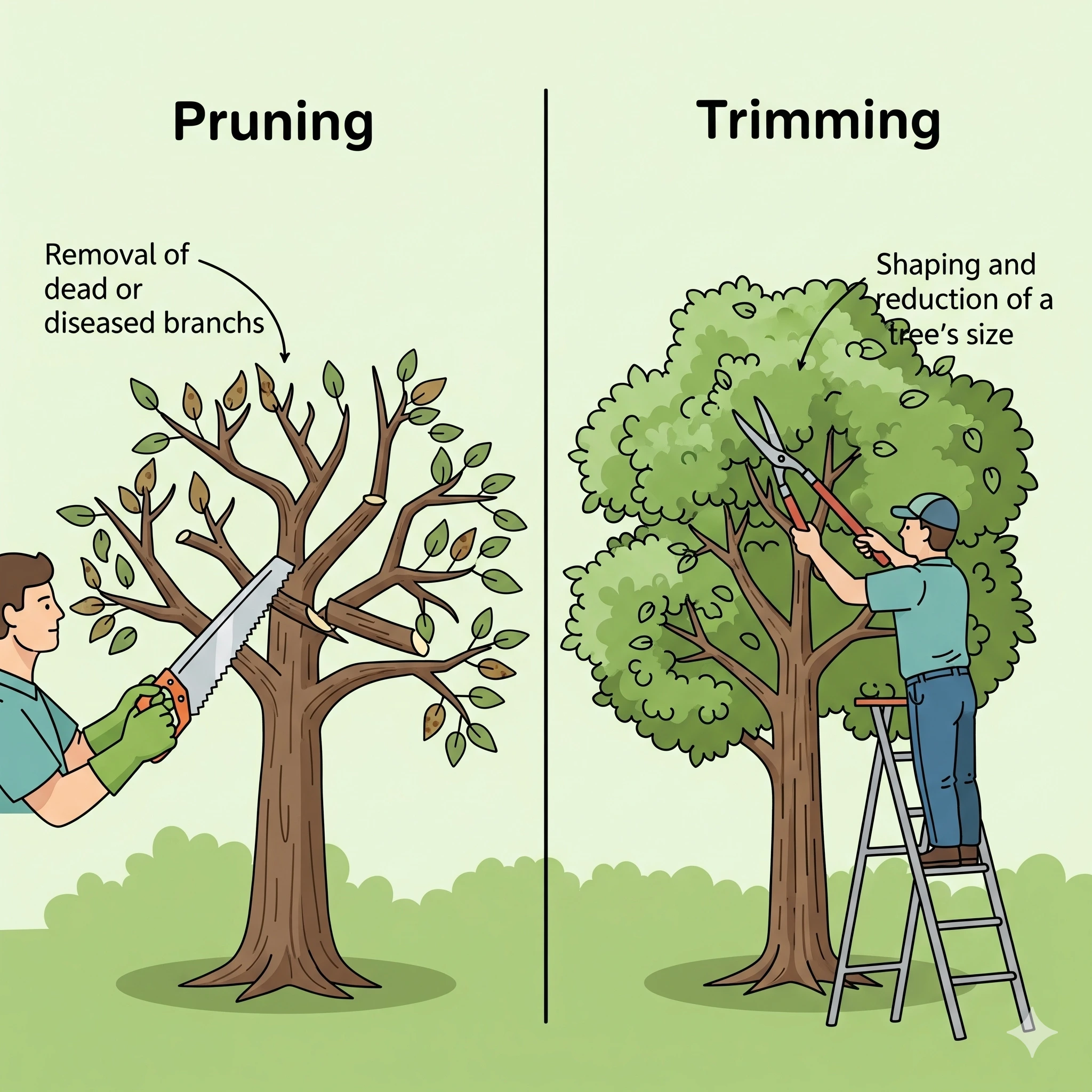Introduction
Trees are more than just greenery in your backyard—they’re living assets that add value, beauty, and shade to your property. But like any asset, they need regular care. That’s where tree pruning and tree trimming come in. While these terms are often used interchangeably, they actually serve different purposes. Understanding the difference can save your trees from unnecessary stress and keep them thriving for years.
Understanding Tree Maintenance
Tree maintenance is not just about making your yard look pretty; it’s about ensuring safety, health, and growth. Regular care helps trees resist disease, prevents overgrowth, and reduces risks like falling branches. With the right balance of pruning and trimming, your trees will remain strong, safe, and beautiful.
What is Tree Pruning?
Tree pruning is all about health and safety. It’s the process of cutting away dead or diseased branches so the tree can grow stronger and healthier. Imagine you had a splinter in your hand—you’d remove it before it caused an infection. That’s exactly what pruning does for trees.
There are different styles of pruning too. For example, removing dead branches (deadwood pruning), thinning out crowded areas (crown thinning), or reducing a tree’s height for safety reasons (crown reduction). Each serves a purpose, but all share the same goal: keeping your tree alive and thriving.
Types of Tree Pruning
- Crown Thinning – Removes smaller branches to increase light and airflow.
- Crown Raising – Cuts lower branches to clear pathways or buildings.
- Crown Reduction – Reduces the tree’s overall size without harming its structure.
- Deadwood Pruning – Eliminates dead or dying branches for safety.
Benefits of Tree Pruning
- Promotes healthier growth by eliminating weak limbs.
- Reduces the risk of falling branches.
- Helps trees resist pests and diseases.
- Encourages flowering and fruit production in certain species.
What is Tree Trimming?
Tree trimming, on the other hand, is less about health and more about looks and space. It’s the haircut your tree needs when it starts looking wild, uneven, or when branches creep too close to your roof or power lines.
If you’ve got a front yard tree that blocks your windows or casts too much shade on your lawn, trimming will fix that. Done properly, it not only improves curb appeal but also prevents branches from becoming a hazard in storms.
Types of Tree Trimming
- Fine Trimming – Light cutting for a neat appearance.
- Standard Trimming – Regular shaping to maintain balance.
- Hazard Trimming – Removing dangerous overhanging branches.
- Crown Reduction Trimming – Lowering height and spread for safety and aesthetics.
Benefits of Tree Trimming
- Keeps your landscape neat and attractive.
- Prevents branches from interfering with roofs, power lines, or walkways.
- Enhances sunlight and air circulation.
- Adds curb appeal and property value.
Key Difference: Pruning vs. Trimming
Here’s the easiest way to remember:
- Pruning = Health (removing what’s harmful to the tree)
- Trimming = Appearance & Safety (shaping and clearing space)
Both are essential, but they serve very different purposes.
When Should You Prune?
- Late winter or early spring is best for most species.
- Prune when you notice dead, weak, or diseased branches.
- Avoid heavy pruning during peak growth seasons to reduce stress.
When Should You Trim?
- Trimming can be done more often, even several times a year.
- Best when branches start obstructing views, paths, or property.
- Great for maintaining landscaping aesthetics.
Common Mistakes in Pruning and Trimming
- Over-pruning weakens trees.
- Cutting during the wrong season can stress the tree.
- Using dull or improper tools may damage the bark.
Tree Pruning Adelaide: Why It Matters
Adelaide’s climate can be tough on trees, with hot summers and cool winters. Professional Tree Pruning Adelaide services help trees adapt to seasonal changes, resist drought stress, and stay healthy year-round. Proper pruning also reduces fire risks in dry conditions—a crucial factor in South Australia.
Choosing Between Pruning and Trimming
If your tree looks unhealthy, pruning is the answer. If it’s growing wild but healthy, trimming is the way to go. Sometimes, a combination of both provides the best results—strong, healthy, and beautiful trees.
Why Hire Professionals like J&B Tree Services?
Tree work isn’t just climbing ladders with scissors. It can be dangerous and requires expertise. J&B Tree Services offers professional pruning and trimming tailored to Adelaide’s climate and tree species. With the right equipment and safety standards, they ensure your trees get the best possible care.
Conclusion
While many people use the terms interchangeably, tree pruning and tree trimming serve very different purposes. Pruning focuses on health, while trimming is about shape and appearance. Both are essential for strong, safe, and beautiful trees. And if you’re in Adelaide, calling experts like J&B Tree Services ensures your trees get the professional care they deserve.
FAQs
1. What happens if you don’t prune or trim your trees?
Neglecting tree care can lead to weak branches, disease, and safety hazards like falling limbs.
2. Can pruning and trimming be done at the same time?
Yes, many professionals combine both techniques depending on the tree’s needs.
3. How often should trees be trimmed in Adelaide?
Most trees benefit from trimming once or twice a year, depending on growth and location.
4. Is DIY tree trimming safe?
Small trimming jobs may be safe, but larger branches or tall trees should always be left to professionals.
5. What makes professional pruning better than DIY?
Professionals know how much to cut, when to cut, and which tools to use—ensuring the tree’s health and your safety.

